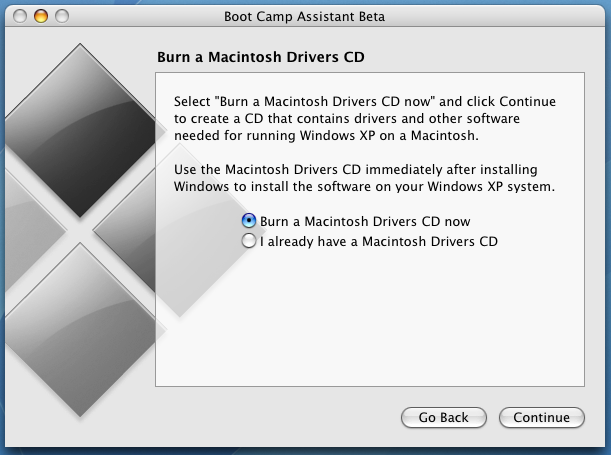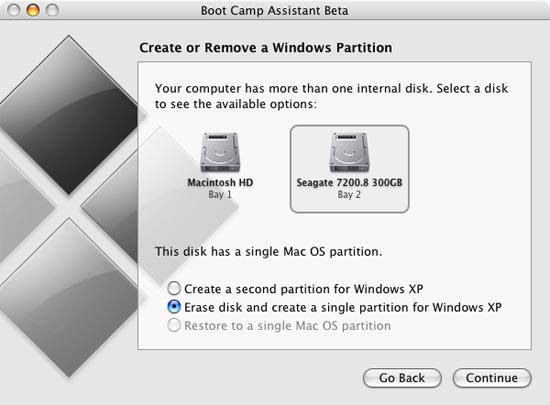- Boot Camp Windows Xp Drivers Windows 7
- Boot Camp Windows Xp Drivers Windows 10
- Boot Camp Windows Xp Drivers Installer
- Boot Camp Windows Xp Drivers Xp
- Anker 3-Port USB 3.0 HUB with 10/100/1000 Gigabit Ethernet Converter (3 USB 3.0 Ports, A RJ45 Gigabit Ethernet Port, Support Windows XP, Vista, Win7/8 (32/64 bit), Mac OS 10.6 and Above, Linux) Black 4.6 out of 5 stars 2,075.
- Compatibility with this software may vary, but will generally run fine under Microsoft Windows 10, Windows 8, Windows 8.1, Windows 7, Windows Vista and Windows XP on either a 32-bit or 64-bit setup. It's a nasty little bug I ran into when trying to connect them to my Macbook Pro running Windows 10 under Bootcamp.
- Prepare necessary drivers (see details below), boot the target computer and use Universal Restore (see details below) to make the restored system bootable on the new hardware. Now you can start the computer and work with your system restored to the new hardware.
This article applies to Windows.
Restoring to dissimilar hardware is not available on Mac (neither for OS X, nor for the Bootcamp partition).
Restore to dissimilar hardware procedure:
The driver provided by Apple is just fine, the problem I had was that Windows Update kept forcing the 2015 driver on my machine, which resulted in corrupt graphics (something I observed in XP, 7, and 8 as well with the 2015/2014 drivers). Choices for Running Windows on a Mac OS X. If you want to run Windows operating systems on your Mac, then you have two choices. You can either run Windows in Boot Camp, a common characteristic of the Mac operating system, or you can utilize a virtualization software package. Hence, we shall be taking a look at Parallels vs BootCamp 2021.
- Create an Acronis bootable media and boot the target computer (connect the media to your computer and restart the computer).
- Perform recovery of the backed up system.
- From your Acronis account, download Acronis Universal Restore media builder and create a bootable media containing Acronis Universal Restore - a free tool available for Acronis customers (see details below), which allows you to make the restored system bootable on dissimilar hardware.
- Prepare necessary drivers (see details below), boot the target computer and use Universal Restore (see details below) to make the restored system bootable on the new hardware.
- Now you can start the computer and work with your system restored to the new hardware.

To be able to download Acronis Universal Restore tool from your account, you need to register your license of Acronis True Image under your account on Acronis website.
- Go to My Products & Downloads;
- Locate Acronis True Image 2016 Universal Restore and click Download:
- Install the downloaded file.
In this step you will create a bootable media to boot your machine after recovery and apply Universal Restore. You do not have to add the drivers now, you should do this later when you start the machine with this media and apply Acronis Universal Restore.
- Start the installed Acronis Universal Restore tool from Windows Start menu.
- Select the way the disks and volume will be represented:
- Optionally, specify Linux kernel parameters. See Linux Kernel Parameters.
- Select Acronis Universal Restore:
- Select the media output:
- Specify the mass storage drivers to be used by Acronis Universal Restore:
You do not have to add the drivers now. You can do this later when you apply Acronis Universal Restore to a machine.
- Click Proceed.
Acronis Universal Restore is a tool that allows changing Windows Hardware Abstraction Layer (HAL.dll) and install mass storage boot device drivers into the system.
It installs boot device drivers (e.g. hard drive or RAID controller drivers) into the system during the recovery process, so that the operating system can boot from this boot device. If there are proper NIC drivers present in the folder with the drivers, Acronis Universal Restore will copy them into the restored system and will schedule their installation on Windows boot-up.
(!) All the other drivers (e.g. video and sound card drivers, plug and play drivers) are not installed by Acronis Universal Restore, as they can be installed in Windows after the successful migration.
Prepare drivers
Before applying Universal Restore to a Windows operating system, make sure that you have the drivers for the new HDD controller and the chipset. These drivers are critical to start the operating system. Use the CD or DVD supplied by the hardware vendor or download the drivers from the vendor’s Web site. The driver files should have the *.inf, *.sys or *.oem extensions. If you download the drivers in the *.exe, *.cab or *.zip format, extract them using a third-party application (e.g. free 7-zip tool or any other).
Boot Camp Windows Xp Drivers Windows 7
Note for Windows XP users: as Microsoft has stopped Windows XP support on April 8, 2014, more and more hardware manufacturers discontinue testing their harware for compatibility with Windows XP, thus you may experience issues when/after restoring a Windows XP system to new hardware. Please consult your hardware manufacturer to make sure the new hardware is compatible with Windows XP.
What if you do not have drivers
Windows 7 includes more drivers than the older Windows operating systems. There is a great chance that Universal Restore finds all necessary drivers in the Windows 7 driver folder. So, you may not necessarily have to specify the external path to the drivers. Nevertheless, performing Universal Restore is critical so the system uses the correct drivers.
The Windows default driver storage folder is determined in the registry value DevicePath, which can be found in the registry key
Boot Camp Windows Xp Drivers Windows 10

HKEY_LOCAL_MACHINESOFTWAREMicrosoftWindowsCurrentVersion

Boot Camp Windows Xp Drivers Installer
This storage folder is usually WINDOWS/inf.
Use Acronis Universal Restore
Boot Camp Windows Xp Drivers Xp
- Boot the machine from the Acronis Bootable Media.
- Select the Acronis Universal Restore option:
- Add a folder with the drivers under Automatic drive search:
- Click OK.
